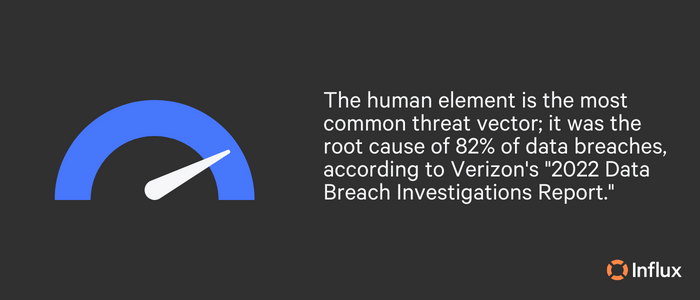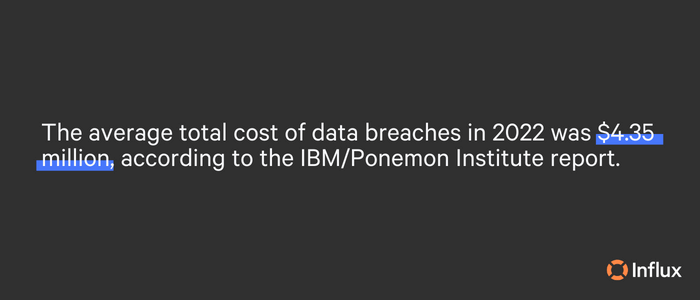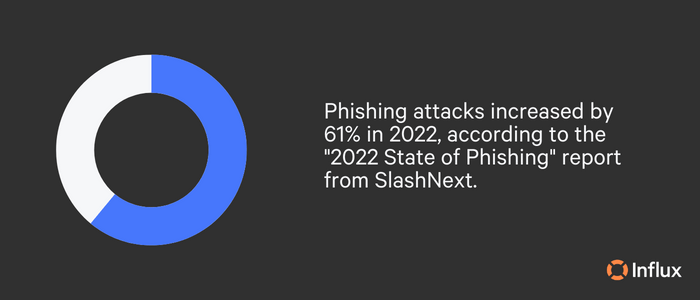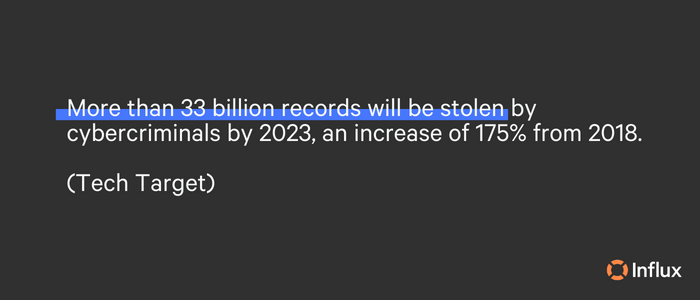Data security is not just about technology, it’s about trust. Protecting sensitive information is a responsibility that requires a combination of technical expertise and a commitment to ethical behavior.
- Influx’s Information Security Officer, Andrew Markham
One of the biggest problems in the digital era is data security. As hackers grow more intelligent and data breaches become more frequent, organizations all around the world are finding themselves in danger. At its worst, a cyber assault can cause irreparable damage to a company and can even result in legal action.
According to the Hiscox Cyber Readiness Report, “A single attack–be it a data breach, malware, ransomware or DDoS attack–cost companies in the U.S. a median of $18,000 in 2022, up from $10,000 in 2021.”
Every business, regardless of size, needs to implement security measures to keep sensitive information safe. Take the proactive steps here to reduce the risk of a security breach.

What is a cyber attack and how do cyber attacks happen?
Combating ignorance is among the best methods to avoid data breaches. There are minor distinctions between ‘cyber attack’ and ‘data breach.’ A cyber attack is an attempt to disable computers, steal data, or use a breached computer system to launch additional attacks. Whereas, a data breach is a cyber attack in which sensitive, confidential or otherwise protected data has been accessed or disclosed in an unauthorized fashion.
The most common types of cyber attacks are:
- Malware (malicious software) that is specifically designed to disrupt, damage, or gain unauthorized access to a computer system.
- Denial-of-service (DOS) attacks that are malicious, targeted attacks that flood a network with false requests in order to disrupt business operations.
- Phishing, which is the fraudulent practice of sending emails or other messages purporting to be from a reputable company in order to induce individuals to reveal personal information, such as password and credit card numbers.
- Spoofing happens when an email is sent from a fake sender address, asking the recipient to provide sensitive data.
- Code injection attacks are when an attacker injects malicious code into a vulnerable computer or network to change its course of action.
- Supply chain attacks target a trusted third-party vendor who offers services or software vital to the supply chain.
Most cyber attacks are motivated by financial gain, but attacks can occasionally be due to pranks, activism, cyber theft, or espionage.
6 steps to keep your business safe
1. Conduct a security risk assessment
A security risk assessment is a procedure for identifying, assessing, and prioritizing current security measures for any potential vulnerabilities. Follow these steps to conduct your own security risk assessment:
- Identify your assets that need to be protected, including systems, data, people, and physical assets.
- Identify potential threats and what risks could affect your assets.
- Evaluate how likely each threat is to occur and what its impact would be.
- Determine which risks are the most pressing and should take priority.
- Identify ways to reduce the likelihood or impact of each risk, such as implementing security procedures.
- Put the risk mitigation plan into action.
- Regularly review for effectiveness and make any necessary changes.
A risk assessment will assist in preventing cyber attacks by allowing you to examine your organization’s security from the viewpoint of an attacker.

2. Educate your employees
Cybersecurity threats are constantly evolving. Therefore, your countermeasures will need to evolve as well. As a best practice, it’s recommended to train employees regularly on security risks and make sure they understand the importance of maintaining the security of sensitive information. Security protocol should be a topic of discussion for all departments throughout the year.
3. Have a password system
Weak passwords are easy to guess and can put important information at risk. Require employees to use strong passwords and implement two-factor authentication wherever possible. Two-factor authentication verifies your identity by using two separate forms of identification in order to access something. It can help to neutralize the risks associated with compromised passwords.

4. Backup data frequently
Regular data backup is an excellent habit to create and maintain. Backing up important data minimizes the risk of data loss in the event of a security breach or other disaster. There are 6 ways to backup data:
- USB sticks
- External hard drives
- Time machine mechanism
- Network attached storage
- Cloud storage
- Printing
Choose a frequency for backups that fits your needs and set up a schedule to ensure that important data is secure.
5. Keep software up to date
Regularly update software, including operating systems and applications, to address known security vulnerabilities. Software updates often have new features, fixes for bugs, and performance improvements. They also often include patches for known vulnerabilities, which can prevent attackers from exploiting them. Because of this, it’s important to install updates promptly and keep software up-to-date to ensure the best possible security for devices and systems.

6. Stay informed
Stay in-the-know about the latest security threats and best practices by regularly reading security-related news and subscribing to security-focused newsletters or blogs.
By following these steps, a business can significantly reduce the risk of a security breach and ensure the protection of sensitive information.
Influx security measures/protocol
Prioritizing security for our customers is not just a responsibility, it’s a commitment to building trust and providing peace of mind in an ever-evolving digital world.
- Influx’s Information Security Officer, Andrew Markham
Influx offers consistent, enterprise level security. Our operational tools and data are hosted on AWS which undergoes various third-party independent audits on a regular basis and can provide verification of compliance controls for its data centers, infrastructure, and operations. This includes, but is not limited to, SSAE 16-compliant SOC 2 certification and ISO 27001 certification.
Our relationships with our clients and partners is driven by the highest level of security for peace of mind solutions. Security measures are a valid concern when partnering with a third-party. Our sales team and security engineers are happy to discuss customizing security requirements within your company for long-term, protected solutions. Discuss security measures with our sales team!

